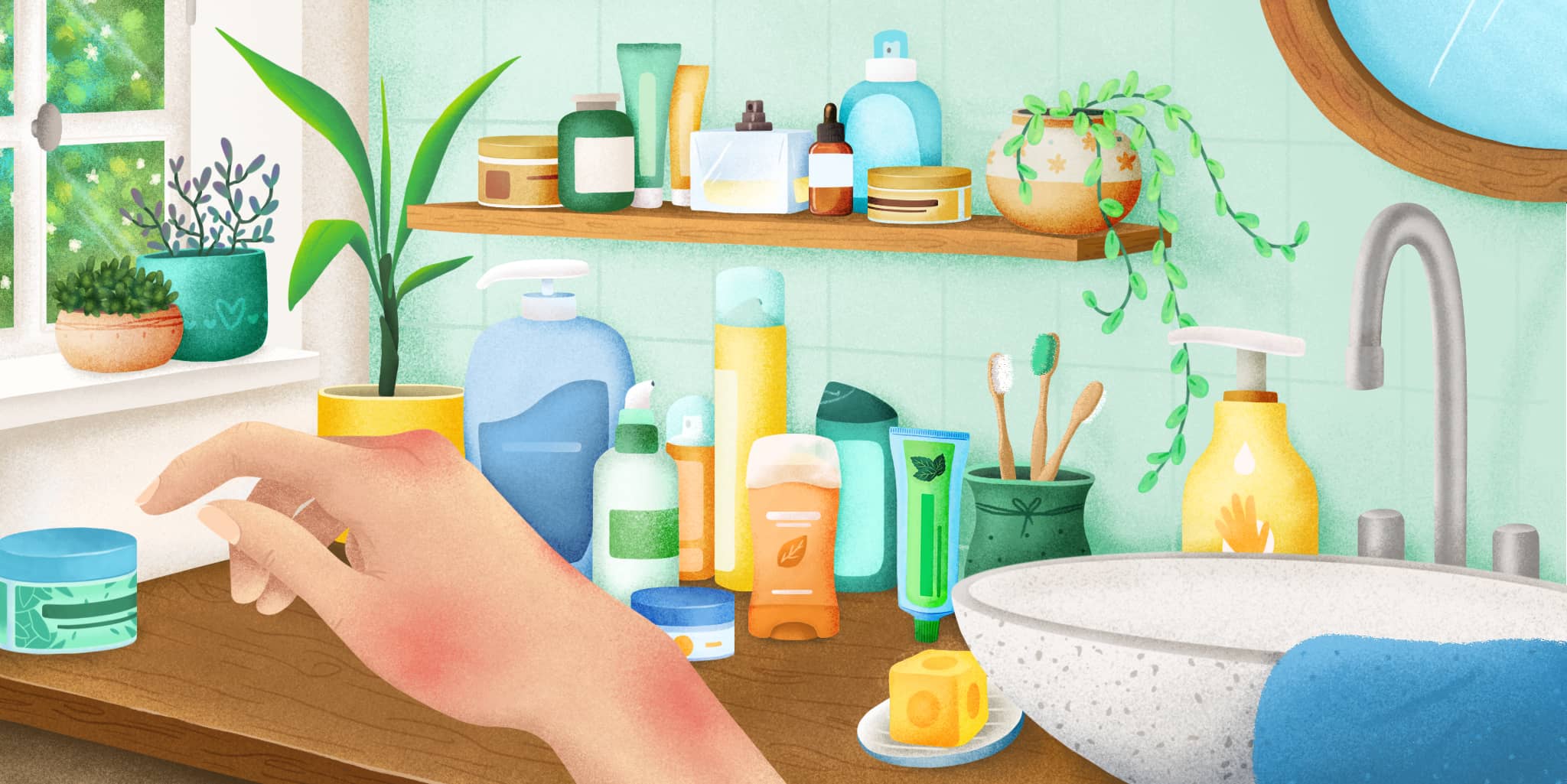
You may have thought you were taking good care of your skin by choosing fragrance-free products to avoid an allergic skin reaction. And then, one day, you suddenly develop an itchy rash. Rest assured that yours is not an isolated case: 10% to 20% of the world’s population experiences an allergy-related irritation to a cosmetic ingredient1,2,3. The WHO even estimates that this number is expected to rise4, particularly in industrialized countries, where there are now almost 3 times as many skin reactions compared with 19965,6.
In this article, we will focus on the ingredients in cosmetic products that can trigger skin allergies. What causes these allergic reactions? Which ingredients should be avoided and what are some tips for choosing the right cosmetic products?
Allergist Séverine Fernandez shares her expertise on the subject.
Allergies: why does our body rebel against certain substances?
An allergic reaction is an inappropriate response of the immune system to a normally harmless environmental substance (the allergen). The body sees the allergen as a threat, like bacteria or a virus, and decides to fight it off with an overreaction.
There are many types of allergens: foods, cosmetic ingredients, pollen, mites, etc. However, bear in mind that the body’s defense mechanism when your skin breaks out in spots or pimples after applying a face cream is by no means comparable to a food allergy to peanuts7.
Mechanism of action: the calm before the storm
One thing that all allergies have in common is their mode of action, which occurs in two stages:
- Initially, there is a period during which we are repeatedly exposed to an allergen. We experience no symptoms, so we assume that everything is fine.Meanwhile, our immune system has already mistakenly perceived this chemical as an enemy. This is the sensitization phase.
- Then, after a certain period of time, which varies from person to person, the body can no longer tolerate contact with this supposed enemy. The body will now produce a reaction every time it is exposed to the antigen. This is the elicitation phase8.
Skin allergies are linked to a specific type of immune cells: attacking white blood cells9. When the allergen is reintroduced into the body through a cosmetic product, these attacking white blood cells are summoned as reinforcements. They are activated, multiply, and release chemical compounds that trigger skin lesions. Their goal is to destroy the invading allergen at all costs. Unfortunately, this reaction also induces a rash and skin inflammation.
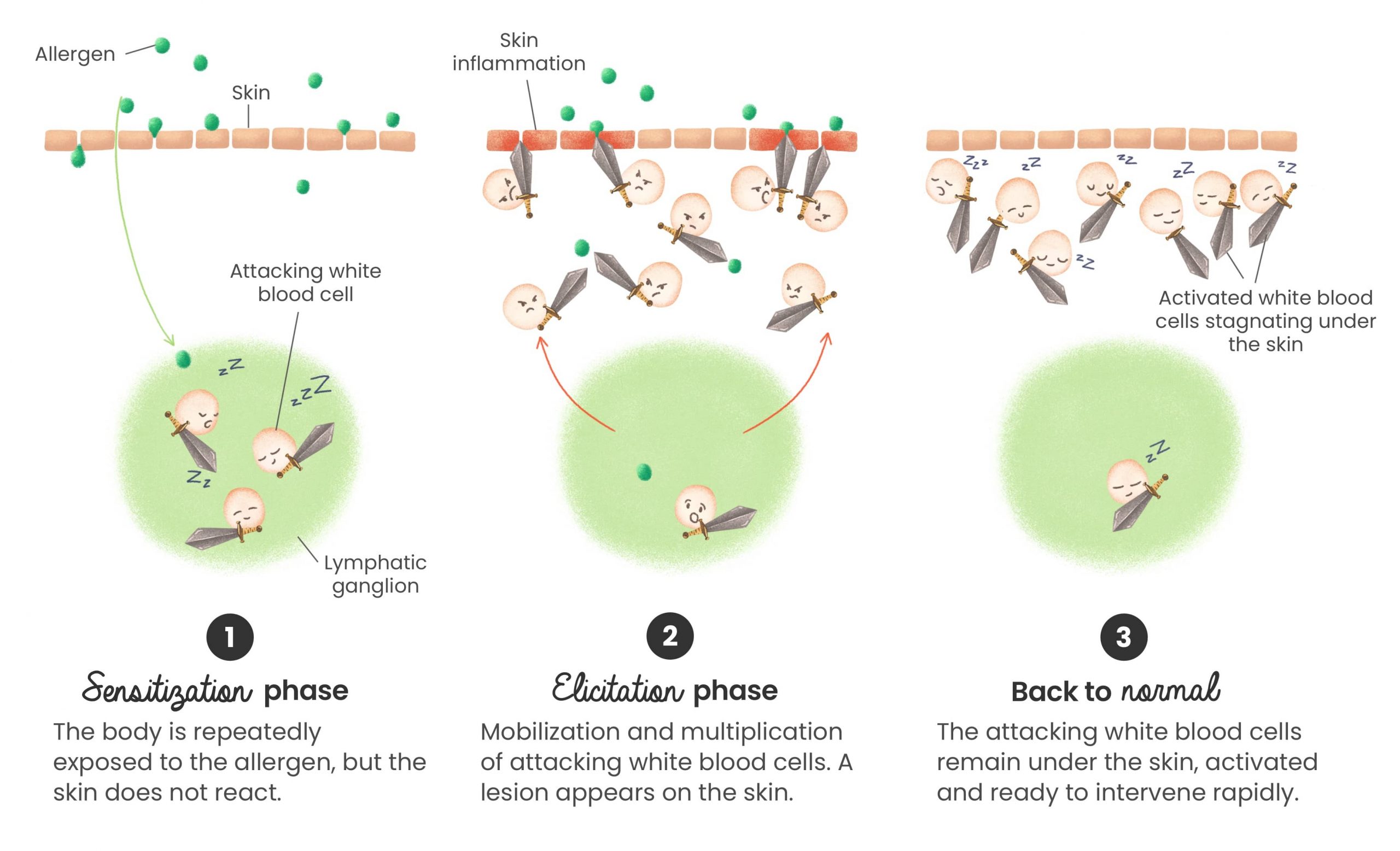
One of the peculiarities of skin allergies is that it is not impossible to develop allergies to several ingredients. This is because various plant extracts may contain the same allergen. For example, it is common to be allergic to geranium and rose essential oils because they both contain geraniol10, a compound on the European Union’s list of allergenic fragrances11.
Symptoms that are no fun
After the silent sensitization phase, – which can last several months, years or even decades, – each subsequent exposure will trigger a skin reaction within 24 to 72 hours. This can result in various symptoms such as severe itching, redness, swelling, dry skin, the appearance of small blisters, etc7. Ouch!
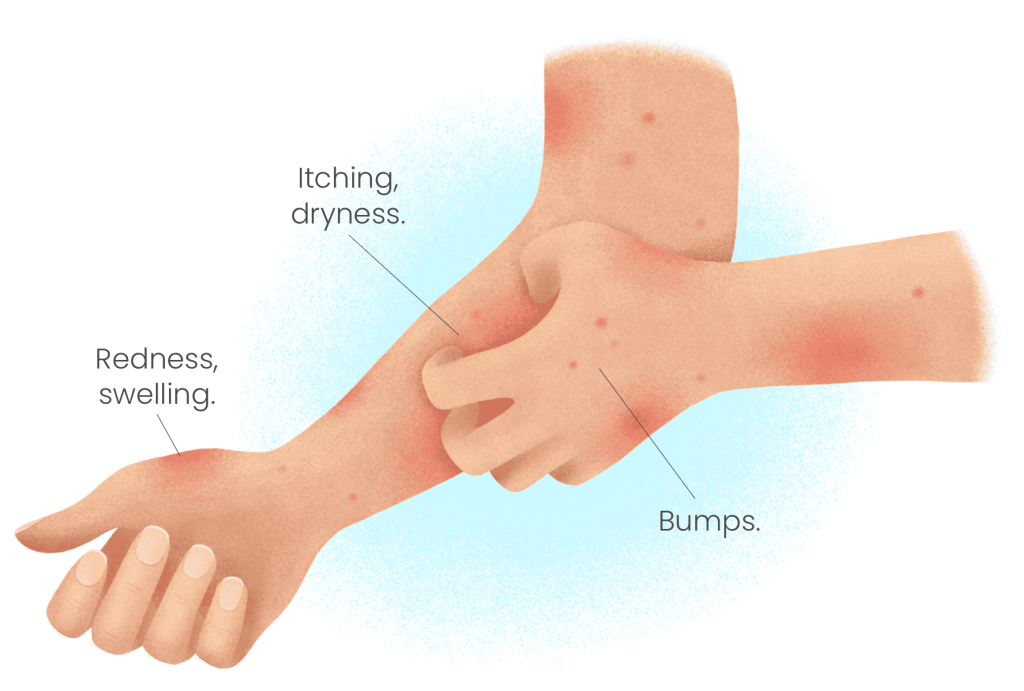
In addition, the symptoms of a skin allergy can typically worsen over time and become increasingly rapid in onset. After several exposures, some attacking white blood cells will remain present in the skin, at the point of usual contact with the allergenic cosmetic (particularly on the hands, face, and armpits). They are standing by, ready to spring into action at the next encounter8. This explains why symptoms can worsen over time and appear in less than 24 hours.
These allergy symptoms should not be confused with irritation, another unpleasant and annoying skin reaction. The latter is a temporary injury to the skin or eyes caused by a substance with corrosive properties. The reaction can occur rapidly and varies based on each individual’s skin resistance and the concentrations used in cosmetic products. This creates a pulling and burning sensation, rather than itching7. Conversely, it is important to remember that an allergy is caused by your body’s overreaction to a harmless substance, even if it is present in very small quantities!
It is therefore easy to understand why it is so important to check for the presence of potential allergens in our cosmetic products, even if we experience no symptoms. The idea is to ensure that your body does not encounter these substances so that, in the future, it will not recognize them as a threat. This is because, once your body’s immune system becomes sensitized to an allergen, there’s no turning back!
Are some people more sensitive than others?
Anyone can suddenly become allergic to a substance, and at any age. However, certain predispositions and environmental phenomena can promote the triggering of this reaction.
Firstly, it is important to remember that damaged skin opens the door to external aggressors. Allergens find it easier to penetrate into barrier-disrupted skin and attach themselves to immune system cells. That is why people with skin conditions, or those who have suffered from skin diseases during childhood, are more likely to develop an allergy later in life. It should be noted that atopic dermatitis, an inflammatory skin disorder affecting 10% of children worldwide, tends to promote a higher prevalence of this sensitization to allergens12.
Another important fact: skin composition varies from person to person. On the surface, enzymes can degrade the simplest external molecules to prevent them from penetrating the skin barrier. How convenient! The problem is that the number and distribution of these enzymes are not the same for everyone3,13. This variability seems to be one of the clues to why some of us are more likely to develop allergies14.
Another clue lies in the ability of our white blood cells to control skin inflammation. These control white blood cells are not there to fight the enemy, but rather to calm things down. Their goal is to ensure that the body does not overreact and to minimize skin damage. An insufficient number of these white blood cells may promote sensitization and worsen the symptoms. However, stress, nutritional deficiencies, viruses, certain diseases, or age could also contribute to a decline in the number of these white blood cells15.
Where are these allergens hiding in our cosmetics?
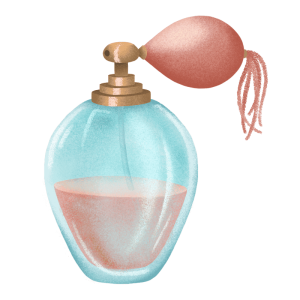 | Fragrances |
Along with preservatives, they are the most common cause of skin allergies16. Fragrances are in fact a cocktail of dozens, or even hundreds of different molecules17. They can be synthetic or of natural origin, and are used in all types of cosmetics such as moisturizers, soaps, deodorants, masks, etc. Many of these substances are listed under the vague label of “fragrance” or “perfume”18,19. This does not make it easy to identify an allergy to one of these highly allergenic substances. Lyral wins the award as the top allergenic substance according to the Scientific Committee on Consumer Safety (SCCS) and has therefore been banned from use in cosmetics in the European Union since 201920. In the USA, its labeling as an allergen is not mandatory and there is no regulation prohibiting its use in cosmetics19. Linalool, geraniol, limonene, natural lichen extract and citral are also known to cause allergic reactions.
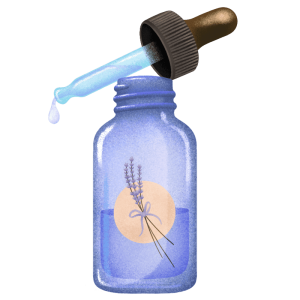 | Essential oils |
Used as a fragrance or due to a wide variety of other properties, many of them are highly allergenic, particularly lemongrass essential oil, jasmine absolute, and sandalwood oil14.
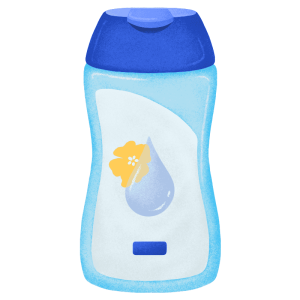 | Preservatives |
On one hand, preservatives are beneficial because they inhibit the growth of microorganisms that could be dangerous to our health. However, some of them are powerful allergens. This is the case, for example, with MIT (Methylisothiazolinone) and MCIT (Methylchloroisothiazolinone). Yet they are used in nearly 20% of shower gels and shampoos21! And what do we know about Quaternium-15? 7% to 10% of Americans are allergic to this substance22,23. It has been banned in the European Union since 201924. Let’s not forget 2-Bromo-2-nitropropane-1,3-diol which is reported to cause allergies in almost 3% of the population according to American studies22,23.
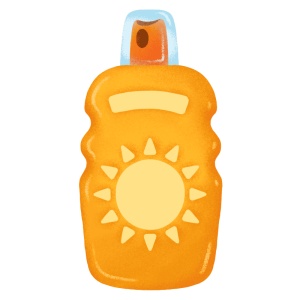 | UV filters |
These compounds are used to absorb the sun’s harmful UV rays which can damage the skin. They are very important in preventing cell aging and the development of skin cancer. But there’s a catch! After exposure to sunlight, some of them can be allergenic. This phenomenon is known as photosensitivity. This is the case with avobenzone, homosalate as well as compounds in the benzophenone family, which are nevertheless widely used ingredients in sunscreen products25. And that’s not all! When they are combined with vitamin A (aka retinol) found in some day creams, this phenomenon may be more pronounced26.
When the good guys become villains.
Some compounds are not allergenic per se, but can degrade into allergenic molecules. This is the case with so-called “formaldehyde-releasing” preservatives such as benzylhemiformal, diazolidinyl urea, DMDM hydantoin, imidazolidinyl urea and methenamine23,27. Their degradation into allergenic molecules is mainly dependent on the cosmetic formulation, acidity, exposure to sunlight and temperature28. Fragrance substances are also subject to this phenomenon. The oxidation of limonene, through exposure to sunlight, caused contact allergy in 3% of subjects tested according to one study14. This compound is present in virtually all plant extracts: essential oils, perfumes, floral waters, etc29. This poses a serious problem.
When the good guys become villains
Some compounds are not allergenic per se, but can degrade into allergenic molecules. This is the case with so-called “formaldehyde-releasing” preservatives such as benzylhemiformal, diazolidinyl urea, DMDM hydantoin, imidazolidinyl urea and methenamine23,27.
Their degradation into allergenic molecules is mainly dependent on the cosmetic formulation, acidity, exposure to sunlight and temperature28. Fragrance substances are also subject to this phenomenon. The oxidation of limonene, through exposure to sunlight, caused contact allergy in 3% of subjects tested according to one study14. This compound is present in virtually all plant extracts: essential oils, perfumes, floral waters, etc29. This poses a serious problem.
In practical terms, what can be done?
- Avoid exposure to contact allergens as much as possible. This will considerably limit sensitization of the immune system to these substances.
- Avoid fragrance substances, even if they are labeled as “natural” or “based on essential oils”. The fact that fragrances are labeled “natural” does not guarantee that they won’t trigger skin irritations or allergic reactions.
- Be particularly vigilant in cases of atopic eczema or chronic irritation, even if this condition has existed since childhood. These pathologies increase the risk of developing a sensitization to contact allergens. The onset of the allergy’s elicitation phase is still possible during adulthood.
- Avoid over-cleansing of the skin. Excessive use of soaps and skin stripping products like scrubs can alter the skin’s natural protective barrier. This can allow the enhanced penetration of allergens and facilitate sensitization to these compounds.
- Take care of your skin with appropriate emollient and moisturizing creams. This will help to maintain the skin’s protective function against external aggressors30.
- When purchasing a product, it is not enough to check for terms such as “hypoallergenic formulation”, “dermatologist tested”, “safe for sensitive skin”, “fragrance-free” or “organic”. These claims do not guarantee the absence of allergens in the formulation19.
- If you develop a contact allergy, consult an allergist to identify the cause and prevent future skin reactions.
Authors: Zoé Kerlo, toxicologist, and Séverine Fernandez, allergist.
- ¹ A.H. Adou, O.R. Yeboah, A.P. Kouacou, S.R. Dassé, K.L. Siransy, Y.J. Seri, A.U. Assi, A.M. Koffi, R.C. Memel, S. Moussa, D. Oura, H. Koya, A.N.J.I. Kouakou, A.S.A. Bognini, K. N’guessan (2023). Profil des lymphocytes T (LT) CD8+ dans l’eczéma allergique de contact (EAC) sur peaux pigmentées. Revue Française d'Allergologie, Volume 63, Issue 3, 2023, 103390, ISSN 1877-0320, https://doi.org/10.1016/j.reval.2023.103390.
- ² Alinaghi, F, Bennike, NH, Egeberg, A, Thyssen, JP, Johansen, JD (2019). Prevalence of contact allergy in the general population: A systematic review and meta-analysis. Contact Dermatitis. 2019; 80: 77–85. https://doi.org/10.1111/cod.13119
- ³ Peiser, M., Tralau, T., Heidler, J. et al (2012). Allergic contact dermatitis: epidemiology, molecular mechanisms, in vitro methods and regulatory aspects. Cell. Mol. Life Sci. 69, 763–781 (2012). https://doi.org/10.1007/s00018-011-0846-8
- ⁴ World Health Organization (2012). White Book on Allergy 2011-2012 Executive Summary. By Prof. Ruby Pawankar, MD, PhD, Prof. Giorgio Walkter Canonica, MD, Prof. Stephen T. Holgate, BSc, MD, DSc, FMed Sci and Prof. Richard F. Lockey, MD
- ⁵ AllergyUK - https://www.allergyuk.org/about-allergy/statistics-and-figures/
- ⁶ Young PA, Gui H, Bae GH (2022). Prevalence of Contact Allergens in Natural Skin Care Products From US Commercial Retailers. JAMA Dermatol. 2022;158(11):1323–1325. doi:10.1001/jamadermatol.2022.3180
- ⁷ Catherine Quéquet (2022). Les nouvelles allergies: Comment les reconnaître ? Comment les combattre ? Editions du Rocher.
- ⁸ M. A. Lefevre, J.-F. Nicolas, M. Vocanson, A. Nosbaum (2021). Rôle des lymphocytes T résidents mémoires dans la physiopathologie des eczémas allergiques de contact. Revue Française d'Allergologie, Volume 61, Issue 2, 2021, Pages 108-113, ISSN 1877-0320, https://doi.org/10.1016/j.reval.2020.10.003.
- ⁹ Vocanson M, Hennino A, Cluzel-Tailhardat M, Saint-Mezard P, Benetiere J, Chavagnac C, Berard F, Kaiserlian D, Nicolas JF (2006). CD8+ T cells are effector cells of contact dermatitis to common skin allergens in mice. J Invest Dermatol. 2006 Apr;126(4):815-20. doi: 10.1038/sj.jid.5700174. PMID: 16456532.
- ¹⁰ Breuer, K., Werfel, T. (2019). Atopic Dermatitis. In: John, S., Johansen, J., Rustemeyer, T., Elsner, P., Maibach, H. (eds) Kanerva’s Occupational Dermatology. Springer, Cham. https://doi.org/10.1007/978-3-319-40221-5_20-2
- ¹¹ Scientific Committee on Consumer Safety (2012). OPINION on Fragrance allergens in cosmetic products. SCCS/1459/11. https://ec.europa.eu/health/scientific_committees/consumer_safety/docs/sccs_o_102.pdf
- ¹² INSERM - https://www.inserm.fr/dossier/dermatite-atopique-eczema-atopique/
- ¹³ European Commission - https://ec.europa.eu/health/scientific_committees/opinions_layman/perfume-allergies/fr/l-3/3-becoming-allergens.htm#0p0
- ¹⁴ Ann Goossens, J.P Lepoittevin (2003). Allergie de contact aux cosmétiques et aux composants de parfums : aspects cliniques, chimiques et diagnostiques nouveaux. Revue Française d'Allergologie et d'Immunologie Clinique, Volume 43, Issue 5, 2003, Pages 294-300, ISSN 0335-7457, https://doi.org/10.1016/S0335-7457(03)00116-3.
- ¹⁵ Marc Vocanson, Anca Hennino, Cyril Chavagnac, Aurore Rozières, Pierre Saint-Mezard, Hitoshi Akiba, Masataka Satoh, Dominique Kaiserlian and Jean-François Nicolas (2006). Eczéma allergique de contact : Comment ré-induire une tolérance ? Med Sci (Paris), 22:2 (2006) 158-163. https://doi.org/10.1051/medsci/2006222158
- ¹⁶ Ann Goossens (2011). Review article : Contact-Allergic Reactions to Cosmetics. Journal of Allergy Volume 2011, Article ID 467071, 6 pages doi:10.1155/2011/467071.
- ¹⁷ M Castelain (2004). Nouveautés en allergologie : eczéma de contact. Revue Française d'Allergologie et d'Immunologie Clinique, Volume 44, Issue 3, 2004, Pages 254-258, ISSN 0335-7457, https://doi.org/10.1016/j.allerg.2004.01.011.
- ¹⁸ European Commission - https://ec.europa.eu/health/scientific_committees/opinions_layman/perfume-allergies/fr/index.htm#5
- ¹⁹ FDA - https://www.fda.gov/cosmetics/cosmetic-ingredients/allergens-cosmetics
- ²⁰ European Parliament and of the Council on cosmetic products, Commission regulation (EU) 2017/1410 - https://eur-lex.europa.eu/legal-content/EN/TXT/?uri=celex%3A32017R1410
- ²¹ Garcia-Hidalgo, E., Sottas, V., von Goetz, N., Hauri, U., Bogdal, C. and Hungerbühler, K. (2017). Occurrence and concentrations of isothiazolinones in detergents and cosmetics in Switzerland. Contact Dermatitis, 76: 96-106. https://doi.org/10.1111/cod.12700
- ²² Anton C. De Groot, Ian R. White, Mari-Ann Flyvholm, Gerda Lensen, Pieter-Jan Coenraads (2010). Formaldehyde-releasers in cosmetics: relationship to formaldehyde contact allergy. Contact Dermatitis. https://doi.org/10.1111/j.1600-0536.2009.01615.x
- ²³ Davis MD, Scalf LA, Yiannias JA, Cheng JF, El-Azhary RA, Rohlinger AL, Farmer SA, Fett DD, Johnson JS, Linehan DL, Richardson DM, Schroeter AL, Connolly SM (2008). Changing trends and allergens in the patch test standard series: a mayo clinic 5-year retrospective review, january 1, 2001, through december 31, 2005. Arch Dermatol. 2008 Jan;144(1):67-72. doi: 10.1001/archdermatol.2007.2. PMID: 18209170.
- ²⁴ European Parliament and of the Council on cosmetic products, Commission regulation (EU) 2019/831 - https://eur-lex.europa.eu/legal-content/EN/TXT/?uri=celex%3A32019R0831
- ²⁵ Anton C. de Groot (1998). Fatal attractiveness: The shady side of cosmetics. Clinics in Dermatology, Volume 16, Issue 1, 1998, Pages 167-179, ISSN 0738-081X, https://doi.org/10.1016/S0738-081X(97)00179-X.
- ²⁶ Gaspar LR, Tharmann J, Maia Campos PM, Liebsch M (2013). Skin phototoxicity of cosmetic formulations containing photounstable and photostable UV-filters and vitamin A palmitate. Toxicol In Vitro. 2013 Feb;27(1):418-25. doi: 10.1016/j.tiv.2012.08.006. Epub 2012 Aug 10. PMID: 22906567.
- ²⁷ J. Waton (2014). Allergènes cachés dans les cosmétiques. Revue Française d'Allergologie, Volume 54, Issue 3, 2014, Pages 207-209, ISSN 1877-0320, https://doi.org/10.1016/j.reval.2014.01.034.
- ²⁸ Mustapha Kireche, Elena Gimenez-Arnau, Jean-Pierre Lepoittevin (2010). Preservatives in cosmetics: reactivity of allergenic formaldehyde-releasers towards amino acids through breakdown products other than formaldehyde. Contact Dermatitis, 63(4), 192–202. doi:10.1111/j.1600-0536.2010.01770.x
- ²⁹ Anton C. De Groot, Erich Schmidt (2016). Essential Oils, Part III: Chemical Composition. Dermatitis. 2016 Jul-Aug;27(4):161-9. doi: 10.1097/DER.0000000000000193. PMID: 27427817.
- ³⁰ Nolan K, Marmur E (2012). Moisturizers: reality and the skin benefits. Dermatol Ther. 2012 May-Jun;25(3):229-33. doi: 10.1111/j.1529-8019.2012.01504.x. PMID: 22913439.





Can you recommend a safe body oil?
I swim outside daily and battle dry skin.
Check eminence organic skin care! I am a spa partner and have a referral link too 🙂
Thanks for this interesting article. I have allergies to many perfumes & smells which give me a headache. I wish the app could let us choose fragrence free preferences products, along with vegan & palm free. Thanks for all you do to help us!
Thank you, Yuka, for sharing this with us all!
Thank you for that information on fragrances and oils, etc. It was very helpful.
For sensitive skin and allergy free products name a few it would be helpful
Hi Diane,
Look into Hale & Hush products.
Excellent article. Thank you very much!
I’ve experienced dermatitis on my eye lids and neck for the past nine months. I believe it is due to an allergy to sulfites, which is in hair and face products including wine. Sulfites is the #1 allergen in 2024 according to the American Contact Dermatitis Association and Dr Christen Mowad. I hope this information is helpful to other people suffering from dermatitis.
Excellent article and very informative!
I can’t figure out what I’m allergic to. Eye creams seem to be the villain. I end up with swollen eyes. I’ve stopped using all eye creams and I’m very careful what I use. I agree – I never had a problem until a few years ago with reactions to facial products.
Muy bueno el artículo , entendí cómo se desarrolla una alergia
Beth, may I suggest getting a patch test done. I just had that test and finally figured out the three things I’m allergic to, for the past year and a half. I’m 77, and have never been allergic to anything in my life! Now I know what to eliminate.
Do you have a scientific explanation for why a friend’s newborn suffered asphyxiation and nearly died from the vitamin K shot given at birth if humans are not born with allergies?
I’m so sorry, I hope the family is healing. I had to re-read the title as well, and remember this is focusing on skin allergies, not allergies in general. Unfortunately, my family has tons of allergies, so this article grabbed my attention.
excellent information, thank you
I have recently developed an allergic reaction to some creams and oils. This article is extremely helpful and valuable. Thank you
Fantastic work.
Sodium benzoate reacts with heat according to this article. Sodium Benzoate with Vitamin C
Although there are no studies that clearly confirm the harmfulness of these additives, it has been proven that when used as a preservative, sodium benzoate can react with vitamin C and thus form carcinogenic benzene [17]. In practice, this combination is often used in colorful, sweetened drinks. In many studies, elevated levels of benzene were reported in carbonated beverages, fruit juices, and other products where benzoate was present in combination with vitamin C [66,67,68,69]. It has been shown that the hydroxyl radical, formed by the metal-catalyzed reduction in O2 and H2O2 by ascorbic acid, can attack benzoic acid to form benzene [70]. However, it is worth noting that heat and light can increase the rate of benzene formation [71]. In one in vivo study, ascorobic acid exacerbated the deleterious effects of sodium benzoate on fertility [39]. Among other things, it potentiated damage to testicular tissue structure and deterioration of semen quality induced by benzoate.
Source: ncbi.nlm.nih.gov
Fantastic and informative article (and the white blood cells are adorable 😉)
Yuka has been such an eye opener for me. It’s amazing how many expensive & recommended products are bad for your skin. I use Yuka every time I shop. The one thing I have not been able to find is a good body lotion. I have very dry, itchy skin. I have literally scanned every body lotion product in major stores & cannot find anything. Could you help me with this?
Same here, Try EMU oil (I use Levin Rose from Amazon) or Lily Hill Whipped Tallow Balm. I have very sensitive skin and have done hours of research to find good quality/safe and non irritating personal care products (coconut and any derivatives for example are a no go for me). I post low tox personal care swaps/reviews on my IG if you’re interested I can send you my handle. Hope this helps!
Xeracalm Nutrition by Avène scores 100% on Yuka. It’s amazing
I agree. I use it and love it.
I have the same issue. I use a baby lotion from Arbonne. It is the only one that doesn’t give me rash or eczema. Maybe a baby product brand may help. Good luck.
The Body Cream by Necessaire has been a game-changer for me! My dry, sensitive skin has never been so happy in my life.
Thanks 💕
After being misdiagnosed with food allergies via rast testing for 0ver 10 years, I finally was able to consult with an allergist who with skin testing discovered I was allergic to two personal care chemicals, Methylchloroisothiazolinone-Methylisothiazolinone & Tixocortol-21-Pivalate. My diagnoses were allergic contact dermatitis and non-allergic chronic rhinitis. She provided me with access to Allergen Information Sheets from ACDS (American Contact Dermatitis Society). This document which for me in a font I can read is over 300 pages long, tells me all the products I CAN use. Life isn’t easier but now I know and no longer have my previous hopeless despair because knowledge is power.
ACDS has an app.
Thank you Julie, for your valuable information. The Yuka app is my best friend in the grocery store!
I love yuca!! Thank you so much for the information.
I appreciate the hard work you all make.
God bless all of you for informing us on so many areas. I love love my yuka app.
Very interesting! Is a really dry scalp/eyebrows indicative of a potential allergy or sensitivity?
All I can say is that before I discovered my chemical allergies, my eyebrows itched several hours after putting on the face cream I loved and used for years. Within days after switching to a cream on my approved list, itching disappeared.
Loved the article. Really helped me as to why I am allergic to BENZYL ALCOHOL
In my case my tongue feels a little rough when getting a whiff of tobacco and perfumes (which now, in my opinion, have fragrance of cleaning products.) I avoid the detergent and softener aisles in supermarkets or pharmacies.
This is a good subject. Thank you for sharing.
Very interesting. Have you written a parallel article about food allergens?
Dimethicone and other silicones found in face and hair serums are really problematic for me and many other people, causing bumps and breakouts even on my 66-year old skin. It’s very difficult to find products without these “cones.”
I have a sensitivity to salicylates. Aloe has salicylic acid in it. Vendors assure me their products have all natural ingredients and they won’t cause me to break out. However, when I ask if they contain aloe, they happily say, “Yes!! That’s part of what’s so good about it!” Bad for me, though.
I have had open sores on my bottom lip for 9 months now. The dermatologist does not know what is causing it. I’ve tried everything from cold sore medication (it is not a cold sore) to topical steroid ointments. The steroids are the only thing that keep it calmed down but they still exist. I use only Yuka approved products and all natural beeswax, no lipstick and charcoal toothpaste and haven’t tried anything new in the 9 months that I’ve had these sores. My derm is ready to do a biopsy on my lip because it hasn’t gone away. Thank you for everything you do.
I was getting sores on my tongue and in my mouth a lot, found out I am sensitive to soy and yeast which is in a lot of products. Had to do the common food allergens (soy, yeast, wheat,milk, eggs, corn, sugar.
Yes. Do the biopsy. I had a sore that would not go away. A biopsy showed it was squamous cancer on my bottom lip. Has to be taken care of. All fine now.
Hope, get the biopsy but in the meantime try some Manuka honey on the sore. It is a miracle worker.
Thanks for this article, recently I’ve developed a bad rash on the sides of my face especially above my eyebrows, So Im going to try and see whats in all my face products. Love your app
Thank you for this very informed article. I fought off perioral dermititis. The use of steroid nose spray, ie Flonase, Nasacort, and the use of Petrolatum as my skin care. It was horrible like Acne. I am so afraid it will come back that I purchase nothing that is not rated Excellent on the App. The skin care I used was sold at the Dermatologist Office. It had to be Good…No, it was very very bad. Our FDA is paid by lobbyists with big Cosmetic Companies here in the US! You are the knowledge to help us be as Safe as we can. Thank You
Thanks for the article. I’m 75 and have steered clear of fragrances in my cosmetics and creams since I began using them as a teenager. I knew they caused breakouts but now I know the physiology of why. My husband breaks out in a rash on his back, armpits and groin if I use a fragranced laundry soap or softener on his underwear. Now, I don’t use them at all on any of his clothes.
Yuka has such a high standard in everything you do and this is just another great example.
What are some companies that have healthy, non-toxic products? I’m interested in make-up and hair products such as volumizer and leave-in treatment. I’m struggling to find any of these products.
I can help you!
Could you please send your list?
https://www.vmvhypoallergenics.com/
Great artricle. Ever since I had Covid I have been sensitive to anything with fragrance. I get a bad headache and my teeth feel numb. I feel like I am eating the fragrance. I have learned that fragrance free still has fragrance in it. Do you have an article that will help me find unscented products. I have found a couple products but need more. I have to do without different products because I can not take the smell. Thank you.
https://www.ewg.org/skindeep/ Go here and you can look for healthy, non-toxic products. Also, you can check the toxicity of products that you use already. They do foods and household products too! I use it all the time. It is a non-profit group so it is not influenced by the companies selling product. Good luck.
Thank you so very much for the article on
Skin Allergies. I love❤️ the illustrations. It helps to understand better🤔
Bless you for the Yuka app and the wonderful articles that help us to make
better choices for our health.
I have shared the Yuka app numerous times while I am shopping.
I love ❤️🩵💛 it.
Great article! I am experiencing a reaction right now and can’t figure out which product is the culprit! Meanwhile I’ve had a rash and itching for over a week. What products can you use to stop the reaction and the itching? Is oral Benadryl the best choice or something more natural? I don’t know what to do!
Cetrizine is only allergy medicine that worked for me. 3 times a day for 2 days then 2 for 4 days then 1 a wk until ready stopped.
Use the app to change your soap lotion and toothpaste to find culprit. Mine was toothpaste.
Great information and easy to understand.
Since I use only green products by Yuka App, my skin looks much, much better!
Love it. Thank you!
Oh my gosh, this article came to me at the right time but honestly I’m not sure what to do. I went to a new hairdresser because I wanted to limit myself to chemicals and decided to use ORGANIC hair color and got a very bad reaction to the product, my scalp is itching like crazy and has gotten very dried out AND woke up with swollen eyelids and I am very flushed in my face! I never had this happen this bad and having been dying my hair for a very long time without organic products. Wondering if I should take Benedril to calm this reaction. Hoping it goes away soon. P.S. Your app is the best and you always have such great articles and I am so appreciative!! 🙂
Thank you very much, can you send me a list of anti-aging products I can trust?
I have a list of toxin free products I am happy to send.
Thanks for explaining!
Thank you for this information. I always wondered why anything with fragrance. was rated as poor or bad? And now I understand. This article has been very helpful!
Very informative!
Great information especially for my sensitive skin, I have always tried to use natural products and they actually keep my skin looking better.
Great information. Thank you for your easy to understand explanation on this topic. Very helpful!!
Thank you !
All the articles are very helpful and informative! I love my Yuka app and recommended to my family ! I used the app all the time!
Awesome article.
Thank you!
As always, great articles !
Thanks. Very interesting.
Thank you, I have red like pimple on my chest arms lower legs, it is not acne. It itches terribly, it is so bad I scratch my in my sleep. I have seen my Dermatologist 5 times, he has prescribed creams, ointments and in the last visit prednisone. I have also allergist and she had no idea, but said it was not an allergy. I have had this for 6 and still my skin is inflamed, thank you for at least explaining this to me no one else has bothered.
Im sorry you are dealing with that. I had something similar from “clean” coconut/algae based products. As soon as I cut those out the tiny bumps went away. Not sure if it’s helpful for you but thought I would share.
Thanks to the amazing team, for the great information, really appreciate your work and guidance, for a healthier lifestyle.
Thanks for the article! I never had a coconut allergy until I started using coconut oil on my skin as lotion. After 3 months of daily coconut oil use, I became highly allergic with horrible itching. Coconut oil is in everything these days (especially hair products). Beware of things that seem benign.
I too love my Yuka app and have recommended it to friends and family. Thank you for this informative article!
Thanks for the article. I’m 75 and have steered clear of fragrances in my cosmetics and creams since I began using them as a teenager. I knew they caused breakouts but now I know the physiology of why. My husband breaks out in a rash on his back, armpits and groin if I use a fragranced laundry soap or softener on his underwear. Now, I don’t use them at all on any of his clothes.
Yuka has such a high standard in everything you do and this is just another great example.
Thank you for continuing to send helpful and informative articles.
I am a HUGE fan of Yuka and have recommend the app to many, many people. It was the only thing that helped me get through a major allergic reaction to hair products containing compounds ending in “ium” which are in 98% of all hair products. I now use Yuka before buying any new product that will be applied to my body.
Keep up the good work and a big thank you from the US!
I want to express what an eye opening experience Yuka app has been.
It is a learning tool for myself, family and friends. Your articles are informative and helpful.
I am grateful for the knowledge it provides and the healthier alternative suggestions in place of harmful and unhealthy products that are promoted by big business who’s main goal is profit. I am a mother and grandmother and making changes to have a healthier life style. I use this app for food and cosmetics and everything I purchase. Many thanks from Canada.
This is an excellent article! Lots of good information on the causes of skin allergies.
This app is so helpful. Im am severely allergic to laundry soap, some hair products, household cleaners and airfreshner.. is there some information you can send me about how toxic this stuff is its ruined my life
Very interesting
I’m a fan of these articles and I use the App everyday it changed my perspective on products that are supposedly good for you but there not.
Really appreciate getting these type of articles from Yuka
Thanks for the information. I have mostly used the app for food. I have started to use it when looking at ingredients on creams, etc. No longer do I shop at Bath and Body where it seems like a lot of the ingredients are toxic, although I have no reactions to them. Why doesn’t the US have these protocols for testing?
Thank you very much for your very informative article. Would you have suggestions for replacing perfumes (if I want to smell good)..?
Very informative. Thank you.
Very informative and interesting thankyou
Thank you for this article. Very informative. I love Yuka and use to check my food and products for my hair and skin. I have by passed many products I used to use and have now replaced with healthier ones. Thanks again.